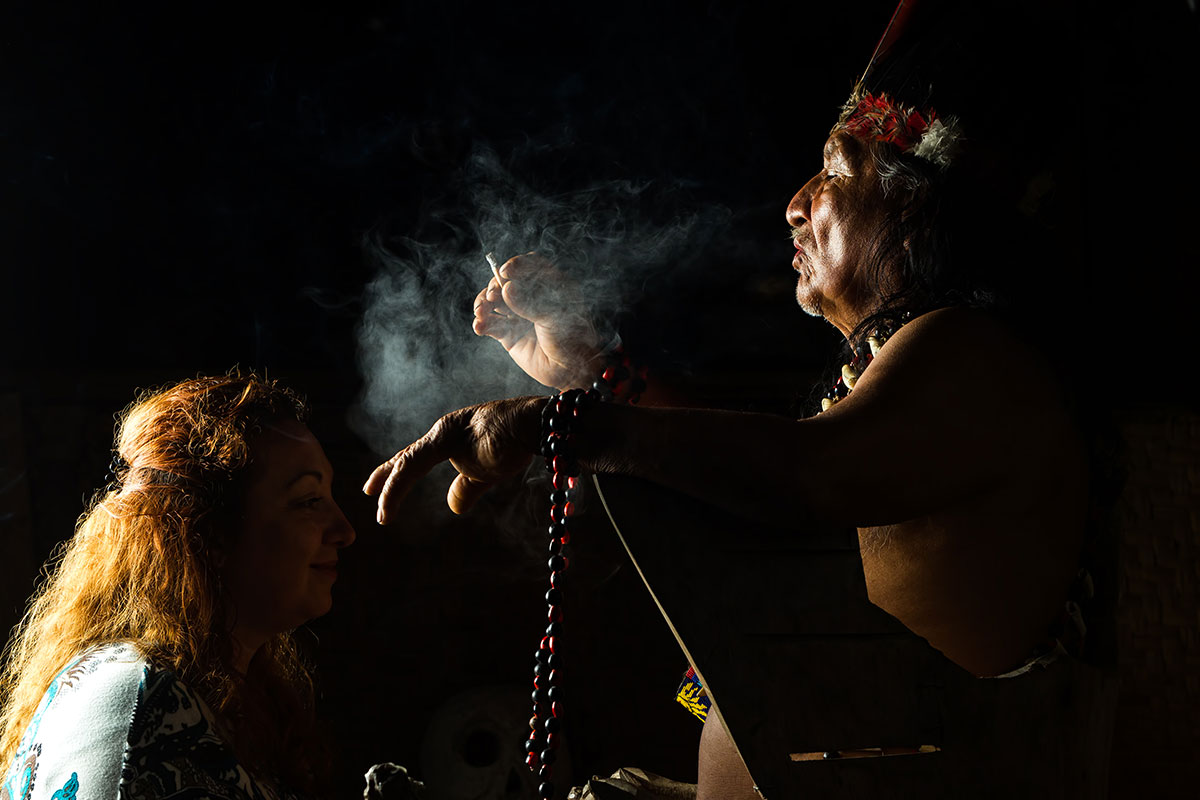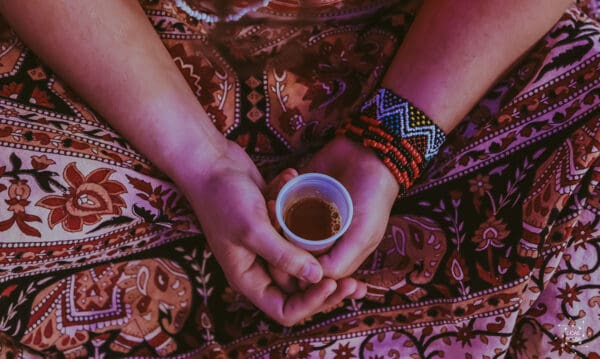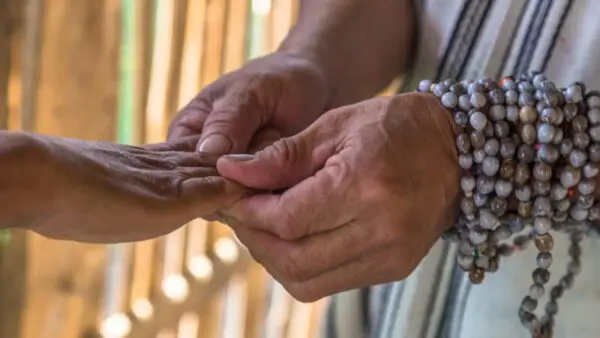The term cultural appropriation refers to the use of artifacts or elements of a non-dominant culture by a person from the dominant culture without reverence or respect for the source. A person of European ancestry wearing a feather headdress is an example of cultural appropriation; the person recognizes neither the spiritual significance of the headdress nor the history of colonization and genocide that has been enacted on the culture they are appropriating.
Writing on the subject, Marisa Wood reflects that “because they do not have a consistent body of rites and cultural traditions, middle-to-upper class non-Indian Americans who belong to the hipster subculture selectively appropriate aspects of minority culture such as the Plains’ Indian headdresses, not to offend its significance, but in order to subconsciously make it, and all they believe it stands for, a part of their own culture.”
Often occurring unwittingly, cultural appropriation serves to perpetuate oppressive dynamics. A person may do it for economic gain and/or status, reinforcing their privilege as a person who can choose at will to adopt the sacred cultural elements of a historically marginalized group for their own benefit.
Other examples of cultural appropriation found in new age/hipster culture, include the commercialization of sweat lodges, vision quests, and sage bundle “smudge sticks” by non-native people. In this last case, not only is the cultural artifact of smudging being misunderstood and appropriated but a plant that is sacred to some indigenous peoples on Turtle Island, the indigenous name for North America, is endangered from overharvesting while people from the dominant culture take it and sell it for their financial gain.
Cultural Appropriation and Psychedelics
In this burgeoning psychedelic renaissance, mainstream culture has a renewed interest in plants and ceremonies that are sacred to certain indigenous cultures.
Peyote, for example, is sacred to many tribes across North America, and yet the National Council of Native American Churches (NCNAC) was neither consulted nor asked permission for the image and name of peyote to be used in promotional material for the Decriminalize Nature movement.
Dawn Davis, Ph.D. (c) and peyote researcher, criticized Decriminalize Nature for not consulting indigenous people before including peyote in a city resolution. In collaboration with NCNAC and the Indigenous Peyote Conservation Initiative (IPCI), they released this statement.
Many western, non-native people have lost connection with their ancestral rites and rituals, and so may seek practices outside of themselves and their culture to find this sense of belonging. Studies have shown that ayahuasca shows tremendous potential for healing some of the ailments that permeate modern society. But, is it considered cultural appropriation for a non-native person to drink ayahuasca?
A Brief History of Ayahuasca
In order to understand the complexity of ayahuasca and cultural appropriation, one must grasp the full history of the plant.
Traditional use of ayahuasca may date back thousands of years. Although the specific origins of its use are unknown, indigenous peoples all over the Upper Amazon Basin and Central America have used ayahuasca for healing, divination, celebration, sorcery, and ritual purposes for at least the last few centuries.
Ayahuasca shamanism has been commercialized and open to non-native peoples for a long time. In the Napo River Basin, where the Amazon River meets the Andes mountains, healers would provide ceremonies to help heal strangers, and would be compensated for the service.
European conquest brought disease to this region, virtually wiping out some areas, and the Rubber Boom only made things worse as indigenous people were captured and enslaved to work in the industry. Missionaries arrived, trying to convert people and extinguish traditional tribal practices. All of this resulted in the loss of some traditional ayahuasca community practices, says Gayle Highpine.
Mestizos, people who have a mixture of European and indigenous ancestry, were drawn to the Amazon for work opportunities, and were naturally exposed to ayahuasca healing practices. Some even became apprentices, bringing the medicine to urban centers to treat poor mestizos living in the city of Iquitos who could access no other health care.
The trauma of the Rubber Boom helped spread the practice of ayahuasca healing, making it part of the global capitalist economy before it became part of the modern tourist industry. Highpine suggests that ayahuasca practices survived because they are detribalized practices; otherwise, they would have been wiped out along with many other cultural artifacts that were destroyed by conquest, disease, industrial expansion, and environmental degradation. For example, the use of ayahuasca was spread by the Santo Daime church’s syncretic use of ayahuasca. It is thought that one of the only reasons that the Santo Daime was able to spread so prolifically is related to the fact that it assimilated with Christian belief.
In sum, there is no original culture to appropriate from per se when it comes to ayahuasca as even some indigenous cultures only started using ayahuasca relatively recently. The practice has been commercialized and considered a profession since pre-modern times, and non-indigenous people have been involved in ayahuasca healing for many years. It is probably not cultural appropriation to drink ayahuasca, however, there are other equally important considerations to be aware of.
Ethical Considerations for Drinking Ayahuasca
#1: Ayahuasca tourism can increase social and economic disparities in local communities. Tourism to the Amazon has complex economic, social, and ecological impacts on the region, including indigenous communities. As financial pressures have mounted, many healers have withdrawn from serving their local communities to become facilitators of ayahuasca ceremonies for foreigners.
Coshikox, a collective organization of Shipibo-Konibo and Xetebo peoples, put forth a statement of concern about foreign interest in ayahuasca and the impacts it is having on their communities. One point was that indigenous youth do not necessarily have the resources to devote themselves to apprenticeships in ayahuasca work, so few are becoming trained to facilitate ceremonies.
What you can do: If traveling to the Amazon or Central America to drink ayahuasca, look for a place that engages in meaningful reciprocity (ayni, in Quechua). Support self-determination of indigenous cultures who practice ayahuasca healing modalities.
Remain aware of current issues, such as spiritual extractivism. Listen to voices from the global South, especially women, who are deeply rooted in ayahuasca traditions. Onanya (the Shipibo word meaning “one who knows,” referring to the role that is commonly, and inaccurately, translated as shaman) should be able to devote their energy to training and educating Shipibo youth, who do not have the same access to resources and opportunities for long apprenticeships as many foreigners have.
If you are attending a ceremony in the US, consider seeking out circles who employ indigenous healers or healers from the Global south. Be mindful about who you are giving your money to; ask if the circle has a sliding scale and what they do to make the medicine accessible to people who have less financial means. While the fancy retreats with high price tags are very attractive and comfortable, more of your money may be going to frills and luxury than to giving back, especially to the places where these traditions originate from.
#2. The widespread interest in ayahuasca gives rise to imposters and charlatans impersonating ayahuasca facilitators. This creates a dangerous situation where uninformed foreigners may end up attending a ceremony with an incompetent facilitator. Indeed, this has led to physical harm, sexual abuse, and death.
It is inconsequential where the facilitator is from or what they look like; anyone can imitate true healers and call themselves a “shaman.” Sometimes, people drink ayahuasca a few times and quickly feel “called” to serve the medicine themselves, without any training or oversight. This is not only dangerous for ceremony attendees, it also degrades and devalues the work of true ayahuasca healers.
What you can do: Remember that ayahuasca can be responsibly facilitated by anyone, regardless of their ethnicity, as long as they are authentically grounded in service of healing (rather than personal gain) and have gone through the rigorous training that it takes to serve the medicine. Vet any retreat center you are considering attending or facilitator you are considering working with. Read these safety guidelines in preparation for an ayahuasca experience to learn more about how to stay safe.
#3. The Amazon Rainforest is facing large-scale deforestation and depletion of its resources. Most people who live in modern society participate in consumer culture which perpetuates the degradation of the natural environment. The Amazon rainforest is home to many ayahuasca traditions, and it is under greatest threat from industries such as cattle ranching, oil extraction, mining, agriculture, logging and palm oil production.
While the ayahuasca vine is not in danger of extinction, some regions have been depleted of all of their wild-growing ayahuasca. With the growing global market, ayahuasca plantations are cultivating the vine to meet the demand.
What you can do: Become informed as a consumer. Ask about the source and sustainability of the medicine before committing to a ceremony.
Do not support corporations that are destroying the Amazon, and limit consumption of products that come from these extractive industries. Support conservation and sustainability efforts toward a more regenerative future for the lungs of our planet and the people who live there.







